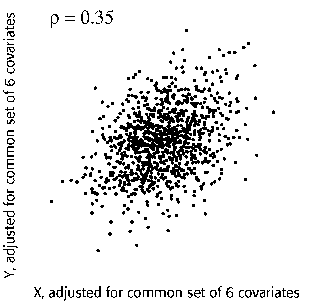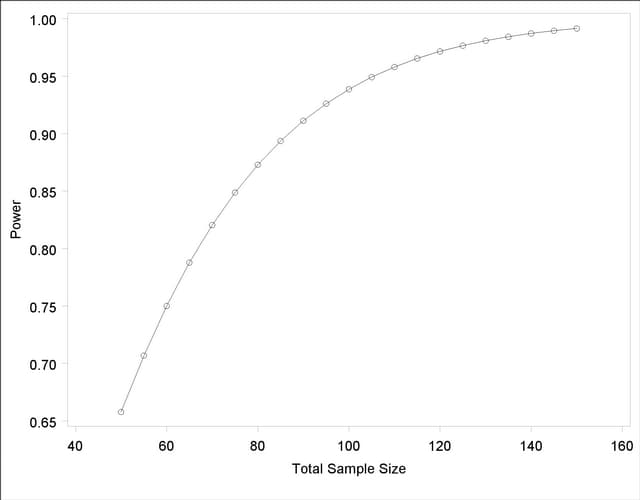| The POWER Procedure |
Example 67.5 Multiple Regression and Correlation
You are working with a team of preventive cardiologists investigating whether elevated serum homocysteine levels are linked to atherosclerosis (plaque buildup) in coronary arteries. The planned analysis is an ordinary least squares regression to assess the relationship between total homocysteine level (tHcy) and a plaque burden index (PBI), adjusting for six other variables: age, gender, plasma levels of folate, vitamin  , vitamin
, vitamin  , and a serum cholesterol index. You will regress PBI on tHcy and the six other predictors (plus the intercept) and use a Type III
, and a serum cholesterol index. You will regress PBI on tHcy and the six other predictors (plus the intercept) and use a Type III  test to assess whether tHcy is a significant predictor after adjusting for the others. You wonder whether 100 subjects will provide adequate statistical power.
test to assess whether tHcy is a significant predictor after adjusting for the others. You wonder whether 100 subjects will provide adequate statistical power.
This is a correlational study at a single time. Subjects will be screened so that about half will have had a heart problem. All eight variables will be measured during one visit. Most clinicians are familiar with simple correlations between two variables, so you decide to pose the statistical problem in terms of estimating and testing the partial correlation between  = tHcy and
= tHcy and  = PBI, controlling for the six other predictor variables (
= PBI, controlling for the six other predictor variables ( ). This greatly simplifies matters, especially the elicitation of the conjectured effect.
). This greatly simplifies matters, especially the elicitation of the conjectured effect.
You use partial regression plots like that shown in Figure 67.9 to teach the team that the partial correlation between PBI and tHcy is the correlation of two sets of residuals obtained from ordinary regression models, one from regressing PBI on the six covariates and the other from regressing tHcy on the same covariates. Thus each subject has "expected" tHcy and PBI values based on the six covariates. The cardiologists believe that subjects whose tHcy is relatively higher than expected will also have a PBI that is relatively higher than expected. The partial correlation quantifies that adjusted association just as a standard simple correlation does with the unadjusted linear association between two variables.

Based on previously published studies of various coronary risk factors and after viewing a set of scatterplots showing various correlations, the team surmises that the true partial correlation is likely to be at least 0.35.
You want to compute the statistical power for a sample size of  = 100 by using
= 100 by using  = 0.05. You also want to plot power for sample sizes between 50 and 150. Use the MULTREG statement to compute the power and the PLOT statement to produce the graph. Since the predictors are observed rather than fixed in advanced, and a joint multivariate normal assumption seems tenable, use MODEL=RANDOM. The following statements perform the power analysis:
= 0.05. You also want to plot power for sample sizes between 50 and 150. Use the MULTREG statement to compute the power and the PLOT statement to produce the graph. Since the predictors are observed rather than fixed in advanced, and a joint multivariate normal assumption seems tenable, use MODEL=RANDOM. The following statements perform the power analysis:
proc power;
multreg
model = random
nfullpredictors = 7
ntestpredictors = 1
partialcorr = 0.35
ntotal = 100
power = .;
plot x=n min=50 max=150;
run;
The POWER=. option identifies power as the parameter to compute. The NFULLPREDICTORS= option specifies seven total predictors (not including the intercept), and the NTESTPREDICTORS= option indicates that one of those predictors is being tested. The PARTIALCORR= and NTOTAL= options specify the partial correlation and sample size, respectively. The default value for the ALPHA= option sets the significance level to 0.05. The X=N option in the plot statement requests a plot of sample size on the X axis, and the MIN= and MAX= options specify the sample size range.
Output 67.5.1 shows the output, and Output 67.5.2 shows the plot.
| Fixed Scenario Elements | |
|---|---|
| Method | Exact |
| Model | Random X |
| Number of Predictors in Full Model | 7 |
| Number of Test Predictors | 1 |
| Partial Correlation | 0.35 |
| Total Sample Size | 100 |
| Alpha | 0.05 |

For the sample size  = 100, the study is almost balanced with respect to Type I and Type II error rates, with
= 100, the study is almost balanced with respect to Type I and Type II error rates, with  = 0.05 and
= 0.05 and  = 1 – 0.937 = 0.063. The study thus seems well designed at this sample size.
= 1 – 0.937 = 0.063. The study thus seems well designed at this sample size.
Now suppose that in a follow-up meeting with the cardiologists, you discover that their specific intent is to demonstrate that the (partial) correlation between PBI and tHcy is greater than 0.2. You suggest changing the planned data analysis to a one-sided Fisher’s  test with a null correlation of 0.2. The following statements perform a power analysis for this test:
test with a null correlation of 0.2. The following statements perform a power analysis for this test:
proc power;
onecorr dist=fisherz
npvars = 6
corr = 0.35
nullcorr = 0.2
sides = 1
ntotal = 100
power = .;
run;
The DIST=FISHERZ option in the ONECORR statement specifies Fisher’s  test. The NPARTIALVARS= option specifies that six additional variables are adjusted for in the partial correlation. The CORR= option specifies the conjectured correlation of 0.35, and the NULLCORR= option indicates the null value of 0.2. The SIDES= option specifies a one-sided test.
test. The NPARTIALVARS= option specifies that six additional variables are adjusted for in the partial correlation. The CORR= option specifies the conjectured correlation of 0.35, and the NULLCORR= option indicates the null value of 0.2. The SIDES= option specifies a one-sided test.
Output 67.5.3 shows the output.
| Fixed Scenario Elements | |
|---|---|
| Distribution | Fisher's z transformation of r |
| Method | Normal approximation |
| Number of Sides | 1 |
| Null Correlation | 0.2 |
| Number of Variables Partialled Out | 6 |
| Correlation | 0.35 |
| Total Sample Size | 100 |
| Nominal Alpha | 0.05 |
The power for Fisher’s  test is less than 50%, the decrease being mostly due to the smaller effect size (relative to the null value). When asked for a recommendation for a new sample size goal, you compute the required sample size to achieve a power of 0.95 (to balance Type I and Type II errors) and 0.85 (a threshold deemed to be minimally acceptable to the team). The following statements perform the sample size determination:
test is less than 50%, the decrease being mostly due to the smaller effect size (relative to the null value). When asked for a recommendation for a new sample size goal, you compute the required sample size to achieve a power of 0.95 (to balance Type I and Type II errors) and 0.85 (a threshold deemed to be minimally acceptable to the team). The following statements perform the sample size determination:
proc power;
onecorr dist=fisherz
npvars = 6
corr = 0.35
nullcorr = 0.2
sides = 1
ntotal = .
power = 0.85 0.95;
run;
The NTOTAL=. option identifies sample size as the parameter to compute, and the POWER= option specifies the target powers.
| Fixed Scenario Elements | |
|---|---|
| Distribution | Fisher's z transformation of r |
| Method | Normal approximation |
| Number of Sides | 1 |
| Null Correlation | 0.2 |
| Number of Variables Partialled Out | 6 |
| Correlation | 0.35 |
| Nominal Alpha | 0.05 |
| Computed N Total | ||||
|---|---|---|---|---|
| Index | Nominal Power | Actual Alpha | Actual Power | N Total |
| 1 | 0.85 | 0.05 | 0.850 | 280 |
| 2 | 0.95 | 0.05 | 0.950 | 417 |
The results in Output 67.5.4 reveal a required sample size of 417 to achieve a power of 0.95 and a required sample size of 280 to achieve a power of 0.85.
Copyright © 2009 by SAS Institute Inc., Cary, NC, USA. All rights reserved.